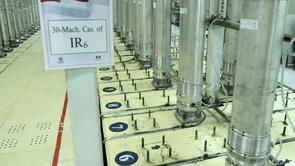 This photo released Nov 5, 2019, by the Atomic Energy Organization of Iran, shows centrifuge machines in the Natanz uranium enrichment facility in central Iran. (ATOMIC ENERGY ORGANIZATION OF IRAN / AP)
This photo released Nov 5, 2019, by the Atomic Energy Organization of Iran, shows centrifuge machines in the Natanz uranium enrichment facility in central Iran. (ATOMIC ENERGY ORGANIZATION OF IRAN / AP)
VIENNA - Iran plans to install hundreds more advanced uranium-enriching centrifuges at an underground plant in breach of its deal with major powers, a UN nuclear watchdog report showed on Friday, a move that will raise pressure on US President-elect Joe Biden.
The confidential International Atomic Energy Agency report obtained by Reuters said Iran plans to install three more cascades, or clusters, of advanced IR-2m centrifuges in the underground plant at Natanz, which was apparently built to withstand aerial bombardment.
READ MORE: IAEA report: Iran feeds uranium gas into advanced centrifuges
“In a letter dated 2 December 2020, Iran informed the Agency that the operator of the Fuel Enrichment Plant (FEP) at Natanz ‘intends to start installation of three cascades of IR-2m centrifuge machines’ at FEP,” the IAEA’s report to its member states said
Iran’s nuclear deal with major powers says Tehran can only use first-generation IR-1 centrifuges, which are less efficient, at the underground plant and that those are the only machines with which Iran may accumulate enriched uranium.
Iran recently moved one cascade of 174 IR-2m machines underground at Natanz and is enriching with it. It already planned to install two more cascades of other advanced models there, in addition to the 5,060 IR-1 machines that have been enriching for years in the plant built for more than 50,000.
“In a letter dated 2 December 2020, Iran informed the Agency that the operator of the Fuel Enrichment Plant (FEP) at Natanz ‘intends to start installation of three cascades of IR-2m centrifuge machines’ at FEP,” the IAEA’s report to its member states said.
Iran has breached many of the deal’s core restrictions on its nuclear activities in response to US President Donald Trump’s withdrawal from the agreement and his reimposition of crippling economic sanctions. Tehran says its breaches can quickly be reversed if Washington’s moves are undone.
Biden, who takes office on Jan 20, has said he will bring the United States back into the deal if Iran resumes full compliance with its nuclear restrictions. That raises the prospect of a standoff over who should move first.
Faster enrichment
Iran transferred the already-operating cascade of IR-2ms underground from an above-ground plant at Natanz where only a handful of those machines remain, the IAEA has said. The extra cascades would therefore have to involve some of the hundreds of IR-2m machines removed and put into storage under the 2015 deal.
While the first cascade did not increase Iran’s production of enriched uranium because it was already enriching above ground, the extra cascades would.
ALSO READ: Iran to boost nuclear fuel production at plant hit by blast
The IAEA’s last quarterly report on Iran last month showed Tehran had stockpiled 12 times the 202.8 kg of enriched uranium it is allowed to have under the deal, more than 2.4 tons.
That is still a fraction of the more than eight tons it had before the landmark 2015 deal, and it has not enriched uranium to a purity of more than 4.5 percent since then. It achieved 20 percent before 2015, closer to the 90 percent of weapons-grade uranium.


